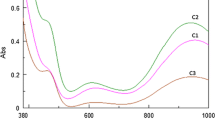Abstract
More than 75 substituted thiosemicarbazones and a number of metal complexes of each have been assayed for their antifungal activity. Their activity is significantly affected by the substituted groups attached at both1 N and4 N of the thiosemicarbazone moiety. Greatest activity occurs for 2-substituted pyridine thiosemicarbazones with differences observed for 2-formylpyridine, 2-acetylpyridine and 2-benzoylpyridine derivatives and their metal complexes. Further, there are activity differences for4 N-alkyl-,4 N-aryl-,4 N-dialkyl- and 3-azacyclothiosemicarbazones and their metal complexes as well as changes in the substituent size among each of these subgroups. Cu(II) complexes are often more active than the uncomplexed thiosemicarbazones, with the latter showing similar activity to Ni(II) complexes in many instances. The reduction potential of the thiosemicarbazone ligand in a Cu(II) complex, the strength of the ligand field and various spectral properties can be correlated to the inhibitory activity.
Similar content being viewed by others
References
Antholine WE, Knight J, Petering DH. 1977 Some properties of copper and zinc complexes of 2-formylpyridine thiosemicarbazones.Inorg Chem 16, 569–574.
Blanz EJ Jr, French FA. 1968 The carsinostatic activity of 5-hydroxy-2-formylpyridine thiosemicarbazone.Cancer Res 28, 2419–2422.
Boyd MR. 1989 Status of the NCI preclinical antitumor drug discovery screen.Princip Pract Oncol 3, 1–12.
Cory JG, Fleischer AE. 1979 Specific inhibitors directed at the individual components of ribonucloetide reductase as an approach to combination chemotherapy.Cancer Res 39, 4600–4604.
Dobek AS, Klayman DL, Dickson ET, Scovill JP, Tramont EC. 1980 Inhibition of clinically significant bacterial organismsin vitro by 2-acetylpyridine thiosemicarbazones.Antimicrob Agents Chemother 18, 27–36.
French FA, Blanz EJ Jr. 1970 Carcinostatic activity of thiosemicarbazones of formyl heterocyclic compounds. 6. 1-formylisoquinoline derivatives bearing additional ring substituents with notes on mechanism of action.J Med Chem 13, 1117–1123.
Grover RK, Moore JD. 1962 Toximetric studies of fungicides against brownrot organismSclerotinia fruticola andS. laxa.Phytopathology 52, 876–880.
Karon M, Benedict WF. 1972 Chromatid breakage: differential effect of inhibitors of DNA synthesis during G2 phase.Science 178, 62.
Klayman DL, Bartosevich JF, Griffin TS, Mason CJ, Scovill JP. 1979 2-acetylpyridine thiosemicarbazones. A new class of potential antimalarial agents.J Med Chem 22, 855–862.
Klayman DL, Lin AJ, McCall JW, et al. 1991 2-acetylpyridine thiosemicarbazones. 13. Derivatives with antifilarial activity.J Med Chem 34, 1422–1425.
Mittal SP, Sharma SK, Singh RV, Tandon JP. 1981 Antifungal activity of some novel lanthanon thiosemicarbazone complexes.Curr Sci 50, 483–484.
Sartorelli AC, Agrawal KC, Tsiftsoglou AS, Moore EC. 1977 Characterization of biochemical mechanism of action of alpha(N)-heterocyclic carboxaldehyde thiosemicarbazones.Adv Enzyme Reg 15, 117–139.
Saryan LA, Mailer K, Krishnamurti C, Antholine W, Petering DH. 1981 Interaction of 2-formylpyridine thiosemicarbazonato copper(II) with Ehrlich ascites tumor-cells.Biochem Pharmacol 30, 1595–1604.
Scovill JP, Klayman DL, Lambrose C, Childs GE, Notsch JD. 1984 2-acetylpyridine thiosemicarbazones. 4. Complexes with transition metals as antimalarial and antileukemic agents.J Med Chem 27, 87–91.
Shipman C, Smith SH, Drach JC, Klayman DL. 1981 Antiviral activity of 2-acetylpyridine thiosemicarbazones against herpes simplex virus.Antimicrob Agents Chemother 19, 682–685.
Wengel A, Jacobsen N, Kolind-Anderson H, Bjerregaard P. 1990 Chitin biosynthesis inhibition and fungicidal effect of thiosemicarbazones of 2-formyl- and 2-acetylpyridine, their hydrogenated derivatives and copper complexes thereof.Pesticide Sci 30, 223–233.
West DX, Carlson CS, Whyte AC, Liberta AE. 1990a Transition metal ion complexes of thiosemicarbazones derived from 2-acetylpyridine. Part 7. Chemical and antifungal properties of 2-acetylpyridine4 N-ethylthiosemicarbazone and its metal complexes.Transition Met Chem 15, 43–47.
West DX, Carlson CS, Galloway CP, Liberta AE, Daniel CR. 1990b Transition metal ion complexes of thiosemicarbazones derived from 2-acetylpyridine. Part 6. Chemical and antifungal properties of 2-acetylpyridine4 N-diethyl- and4 N-dipropylthiosemicarbazones and their copper(II) complexes.Transition Met Chem 15, 91–95.
West DX, Carlson CS, Liberta AE, Albert JN, Daniel CR. 1990c Transition metal ion complexes of thiosemicarbazones derived from 2-acetylpyridine. Part 8. The chemical and antifungal properties of nickel(II) complexes of 2-acetylpyridine4 N-diethyl- and4 N-dipropylthiosemicarbazones and their copper(II) complexes.Transition Met Chem 15, 341–344.
West DX, Carlson CS, Liberta AE, Scovill JP. 1990d The chemical and antifungal properties of the copper(II) complexes of 2-acetylpyrazine4 N-methyl-,4 N-dimethyl-, and 3-hexamethyleneiminylthiosemicarbazones.Transition Met Chem 15, 383–387.
West DX, Carlson CS, Bouck KJ, Liberta AE. 1991a Transition metal ion complexes of thiosemicarbazones derived from 2-acetylpyridine. Part 10. A comparison of the chemical and antifungal properties of the copper(II) complexes and 2-acetylpyridine 3-pyrrolidinyl, 3-piperidinyl-, 3-hexamethyleneiminyl and 3-azabicyclo[3.2.2] nonylthiosemicarbazones.Transition Met Chem 165, 271–275.
West DX, Padhye SB, Sonawane PB. 1991b Structure and physical correlations in the biological properties of transition metal heterocyclic thiosemicarbazone andS-alkyldithiocarbazates.Struct Bond 76, 1–50.
Author information
Authors and Affiliations
Rights and permissions
About this article
Cite this article
Liberta, A.E., West, D.X. Antifungal and antitumor activity of heterocyclic thiosemicarbazones and their metal complexes: current status. Biometals 5, 121–126 (1992). https://doi.org/10.1007/BF01062223
Received:
Accepted:
Issue Date:
DOI: https://doi.org/10.1007/BF01062223




